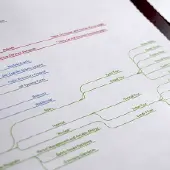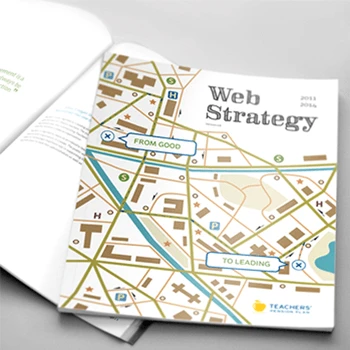What exactly is card sorting research and why do organizations need it?
Card sorting is a user research method that reveals how users naturally organize and categorize information, helping create intuitive information architectures for websites and applications. Organizations need card sorting because it exposes users' mental models, showing how people think about content relationships rather than relying on internal assumptions. This research method provides fast, quantitative feedback on information organization that makes sense to actual users.
Tip: Conduct card sorting early in the design process before wireframing begins, as it's much easier to adjust information architecture than to redesign interfaces around poor content organization.
How does card sorting fit within the Experience Thinking framework?
Card sorting is fundamental to the content quadrant of our Experience Thinking framework, helping establish how information flows across brand, product, and service experiences. Through systematic analysis of user mental models, card sorting ensures content architecture supports connected experiences rather than isolated information silos. This research reveals content relationships that enable seamless user journeys across all touchpoints in your experience ecosystem.
Tip: Consider how card sorting insights will impact all four Experience Thinking areas rather than just focusing on website navigation, as content organization affects brand perception, product usability, and service delivery.
What's the difference between open, closed, and reverse card sorting?
Open card sorting allows participants to freely group content and create their own category labels, revealing natural mental models. Closed card sorting has participants place content into predetermined categories to test whether existing labels make sense. Reverse card sorting tests comprehension by asking users to identify which category specific content belongs in. Each method serves different research goals in information architecture development.
Tip: Use open card sorting for initial discovery, closed card sorting to validate proposed categories, and reverse card sorting to test final information architecture before implementation.
What types of organizations benefit most from card sorting research?
Organizations with complex content ecosystems see the greatest value from card sorting research. This includes technology companies with extensive documentation, healthcare organizations with varied information types, financial services with diverse product offerings, government entities with citizen-facing content, and educational institutions managing multiple stakeholder needs. Any organization where users struggle to find information benefits significantly from understanding user mental models.
Tip: Evaluate card sorting value based on user frustration with information findability and content complexity rather than just website size or content volume.
When is the best time to conduct card sorting during a project?
Card sorting is most valuable early in the design phase, after content audit and user research but before interaction design begins. It should happen when information architecture is malleable and changes are relatively easy to implement. Card sorting provides the foundation for navigation design, content strategy, and user interface development.
Tip: Schedule card sorting after you understand what content you have and who your users are, but before you start designing specific interface layouts or navigation systems.
How does card sorting research support business goals beyond just organizing content?
Card sorting drives business outcomes by improving user task completion rates, reducing support costs, increasing conversion rates through better findability, and supporting search engine optimization through logical content hierarchies. Understanding user mental models enables more effective content strategy, reduces user frustration, and creates competitive advantages through superior information accessibility and user experience.
Tip: Connect card sorting insights to specific business metrics like task completion rates, support ticket volume, and conversion goals rather than just organizing content for organization's sake.
What role does foresight design play in card sorting strategy?
Foresight design in card sorting anticipates future content types, evolving user needs, emerging interaction patterns, and changing organizational structures. This forward-thinking approach creates flexible information architectures that can accommodate growth, new content formats, and changing user expectations while maintaining logical organization principles that users understand intuitively.
Tip: Design card sorting studies that test information architecture scalability for future content and user needs rather than just optimizing for current website content and structure.
What does a typical card sorting research process include from start to finish?
Our card sorting process begins with content analysis and participant recruitment, followed by research design including card selection and category preparation. We conduct sessions using appropriate modality (in-person or remote), analyze results using statistical clustering methods, validate findings through additional testing, and provide actionable recommendations for information architecture development. The process integrates with broader Experience Thinking methodology.
Tip: Plan card sorting as an iterative process with validation phases rather than a single study that produces final recommendations without user feedback on proposed solutions.
How do you determine what content to include in card sorting studies?
Content selection involves analyzing existing information through content audits, identifying user task-critical content through user research, selecting representative content that covers key categories without overwhelming participants, and ensuring content variety that tests important organizational decisions. We typically include 60-150 items that represent core content users need to find and use.
Tip: Include content that represents real user tasks and information-seeking behaviors rather than just organizing all available content, as users care about findability for specific needs.
What participant recruitment strategies do you use for card sorting research?
Participant recruitment focuses on actual users rather than internal stakeholders, using multiple recruitment channels including customer databases, user research panels, social media, and professional networks. We ensure diverse representation across user segments, verify participant qualifications through screening questions, and recruit sufficient sample sizes for statistical analysis. Real users provide unbiased insights into mental models.
Tip: Prioritize recruiting participants who actually use your type of content or website rather than convenient internal volunteers, as employee mental models often differ significantly from user perspectives.
How do you conduct moderated versus unmoderated card sorting sessions?
Moderated sessions allow real-time observation and questioning, providing deeper insights into participant reasoning, decision-making processes, and areas of confusion. Unmoderated sessions enable larger sample sizes and reduced bias from researcher presence, while being more cost-effective for statistical analysis. We choose methodology based on research goals, timeline, and desired insight depth.
Tip: Use moderated sessions when you need to understand the 'why' behind user decisions, and unmoderated sessions when you need larger sample sizes for statistical confidence in patterns.
What statistical analysis methods do you use for card sorting results?
Statistical analysis includes hierarchical cluster analysis to identify content groupings, similarity matrices to understand content relationships, dendrograms to visualize clustering patterns, and agreement analysis to measure consensus across participants. We examine which content consistently groups together, identify ambiguous items, and determine optimal category structures based on user behavior patterns.
Tip: Focus on patterns of high agreement between participants rather than trying to accommodate every individual variation, as consistent patterns indicate stronger user mental models.
How do you validate card sorting results through additional testing?
Validation includes reverse card sorting to test category comprehension, tree testing to evaluate navigation effectiveness, first-click testing to assess initial user paths, and task-based testing with prototype information architectures. This multi-method approach ensures card sorting insights translate into effective user experiences and successful task completion.
Tip: Always validate card sorting results with task-based testing rather than assuming statistical patterns will automatically translate to successful user experiences in real scenarios.
How does artificial intelligence enhance card sorting research and analysis?
AI accelerates card sorting analysis through automated pattern recognition, natural language processing of participant comments, predictive modeling of optimal categories, and rapid analysis of large datasets. However, AI insights require human interpretation for strategic decisions about information architecture and user experience implications. We use AI to enhance analysis speed while maintaining human expertise for research design and recommendation development.
Tip: Use AI for initial pattern identification and data processing but ensure human researchers validate insights and make strategic recommendations about information architecture based on business context and user needs.
How does card sorting research improve website performance and user experience?
Card sorting improves performance by creating intuitive navigation that reduces user search time, increases task completion rates, decreases bounce rates from frustrated users, and improves search engine optimization through logical content hierarchies. Users find information faster, complete desired actions more successfully, and have more positive website experiences when content organization matches their mental models.
Tip: Establish baseline metrics for current information findability and task completion before card sorting to measure improvement in user performance post-implementation.
What return on investment can organizations expect from card sorting research?
Card sorting ROI comes from reduced support costs through better self-service, improved conversion rates through easier task completion, decreased development costs through early architecture validation, and increased user satisfaction leading to higher retention. Organizations typically see measurable improvements in user success rates, reduced time-to-information, and lower support ticket volume for navigation-related issues.
Tip: Track user behavior metrics like task completion rates, time-on-task, and support ticket themes before and after implementing card sorting insights to quantify research value and business impact.
How does card sorting support search engine optimization and content discoverability?
Card sorting supports SEO by creating logical content hierarchies that search engines understand, establishing clear topical relationships for internal linking strategies, identifying natural keyword groupings for content optimization, and reducing content sprawl through better organization. Search engines favor websites with clear information architecture and logical content relationships.
Tip: Consider SEO implications during card sorting analysis by examining how content groupings align with search behavior and keyword strategy rather than treating SEO as a separate post-research activity.
What competitive advantages does strategic card sorting research provide?
Strategic card sorting creates competitive advantages through superior information accessibility, better user task support, faster content findability, and more intuitive user experiences than competitors with poorly organized content. Organizations with user-centered information architecture can onboard users faster, support complex tasks more effectively, and provide better self-service experiences.
Tip: Analyze competitor information architecture and user feedback during card sorting to identify differentiation opportunities through superior content organization and user experience design.
How does foresight design in card sorting prepare organizations for digital transformation?
Foresight design creates information architectures that anticipate omnichannel content distribution, voice interface compatibility, mobile-first usage patterns, and AI-powered content recommendation systems. By understanding fundamental user mental models, card sorting supports digital transformation through flexible architectures that work across emerging platforms and interaction modalities.
Tip: Consider how card sorting insights will adapt to voice search, mobile applications, and AI-powered content systems rather than just optimizing for current desktop website navigation.
What impact does card sorting have on content strategy and governance?
Card sorting informs content strategy by revealing natural content relationships, identifying content gaps users expect to find, establishing logical content hierarchies for creation workflows, and providing user-validated organization principles for governance frameworks. Better content organization reduces duplication, improves content maintenance efficiency, and supports strategic content planning.
Tip: Use card sorting insights to establish content governance rules and creation guidelines rather than just reorganizing existing content, as research reveals principles for future content development.
How does card sorting research reduce website maintenance and support costs?
Card sorting reduces costs by creating intuitive organization that requires less user support, establishing clear content ownership through logical groupings, reducing navigation-related support tickets, and improving user self-service success rates. Better information architecture means users find answers independently and require less assistance from support staff.
Tip: Calculate current support costs for navigation and findability issues to establish baseline figures for measuring post-implementation cost savings from improved information architecture.
How many participants do you typically recruit for card sorting studies?
Participant numbers depend on study goals and methodology. Qualitative studies require 8-12 participants per user segment for pattern identification, while quantitative studies need 20-30+ participants for statistical confidence. Moderated studies can be smaller for deeper insights, while unmoderated studies benefit from larger samples for pattern validation. We balance sample size with budget and timeline constraints.
Tip: Focus on recruiting the right participants rather than just hitting large numbers, as insights from relevant users are more valuable than data from inappropriate participants.
What tools and platforms do you use for conducting card sorting research?
We use specialized card sorting platforms including OptimalSort, UserZoom, and custom solutions depending on study requirements. Tools enable both moderated and unmoderated sessions, provide statistical analysis capabilities, support different card sorting methodologies, and integrate with broader user research workflows. Tool selection depends on participant needs, analysis requirements, and integration considerations.
Tip: Choose card sorting tools based on analysis capabilities and participant experience rather than just cost, as poor tools can compromise research quality and participant engagement.
How do you handle card sorting for complex content with specialized terminology?
Complex content requires careful preparation including plain language alternatives for jargon, clear content descriptions without bias, expert review of content selection, and participant pre-screening for domain knowledge. We balance maintaining accurate terminology with ensuring participant comprehension, often testing multiple versions of content labels to identify optimal user-friendly language.
Tip: Test content terminology comprehension before full card sorting studies rather than assuming participants understand industry jargon or technical language that may seem obvious to internal teams.
What considerations apply to card sorting for mobile and responsive design?
Mobile card sorting addresses touch interface constraints, screen size limitations, content prioritization for smaller displays, and gesture-based interaction patterns. We consider how information architecture translates across device types, test navigation concepts on actual mobile devices, and ensure content organization works effectively regardless of screen size or interaction method.
Tip: Conduct mobile-specific card sorting studies rather than assuming desktop information architecture will automatically work on mobile devices, as mobile usage patterns often differ significantly.
How do you approach card sorting for international or multicultural audiences?
International card sorting addresses cultural differences in categorization, language variations in content terminology, regional business practice differences, and local compliance requirements. We recruit participants from target markets, translate content appropriately, consider cultural context in analysis, and ensure information architecture works across different cultural mental models.
Tip: Include local cultural experts in international card sorting studies rather than just translating content, as categorization patterns and mental models vary significantly across cultures.
What about card sorting for accessibility and inclusive design considerations?
Accessible card sorting includes participants with disabilities, tests compatibility with assistive technologies, ensures clear content descriptions for screen readers, and considers cognitive accessibility in task design. We design studies that work for diverse abilities and ensure resulting information architectures support all users effectively.
Tip: Include accessibility considerations in card sorting design from the beginning rather than adapting results later, as accessible information architecture benefits all users while ensuring compliance requirements.
How do you handle card sorting when organizational stakeholders disagree with user research findings?
Stakeholder disagreements are addressed through additional evidence gathering, business case development for user-centered design, compromise solutions that balance user needs with business constraints, and education about user research value. We help organizations understand the cost of ignoring user mental models while finding practical implementation approaches.
Tip: Present card sorting findings with clear business implications and user task completion data rather than just statistical patterns, as stakeholders need to understand practical value of user-centered organization.
How long does a typical card sorting research project take from start to finish?
Card sorting timelines vary based on study complexity and scope. Simple studies require 2-4 weeks including planning, recruitment, sessions, and analysis. Complex studies with multiple user segments or validation phases may need 6-8 weeks. The timeline includes participant recruitment, study execution, statistical analysis, validation testing, and recommendation development with stakeholder review.
Tip: Plan card sorting timelines based on recruitment challenges and analysis complexity rather than just session duration, as participant recruitment often takes longer than expected.
What deliverables do you provide at the end of a card sorting project?
Card sorting deliverables include detailed analysis reports with statistical findings, recommended information architecture based on user mental models, visual representations of content groupings and relationships, validation testing results, implementation guidelines for development teams, and prioritized recommendations for iterative improvement. All deliverables are designed for practical use by design and development teams.
Tip: Ensure card sorting deliverables include implementation guidance and rationale rather than just statistical results, as development teams need practical direction for translating research into design decisions.
How do you prioritize card sorting recommendations for implementation?
Recommendations are prioritized based on user agreement strength, business impact potential, implementation complexity, and technical constraints. We focus on high-confidence findings with clear user benefits first, while identifying areas requiring additional research or phased implementation. Prioritization considers both quick wins and strategic improvements.
Tip: Start with card sorting recommendations that show strongest user agreement and lowest implementation complexity to build organizational confidence in user research before tackling more challenging changes.
What ongoing support do you provide during information architecture implementation?
Implementation support includes design consultation during wireframing, validation testing of prototype navigation, iterative refinement based on usability testing, training for internal teams on information architecture principles, and guidance for future content organization decisions. We ensure card sorting insights translate effectively into user experience design.
Tip: Plan for implementation support during card sorting project planning rather than assuming research deliverables will be sufficient guidance for design and development teams without consultation.
How do you measure the success of implemented card sorting recommendations?
Success measurement includes user task completion rate improvements, reduced time-to-information metrics, decreased navigation-related support tickets, improved user satisfaction scores, and better search success rates. We establish baseline measurements before implementation and track improvements over time to demonstrate research value and identify areas for further optimization.
Tip: Establish clear success metrics before implementing card sorting recommendations rather than trying to measure impact after changes are made, as baseline data is essential for demonstrating improvement.
What happens when card sorting reveals that current content organization is fundamentally flawed?
Major organizational flaws become opportunities for significant user experience improvement rather than problems to minimize. We help stakeholders understand the business case for addressing fundamental issues, develop phased implementation approaches for major changes, and create communication strategies for explaining changes to users. Large improvements often justify significant organizational investment.
Tip: Frame major card sorting findings as competitive opportunities rather than problems, as significant improvements in information architecture can create substantial differentiation from competitors with poor organization.
How do you ensure card sorting insights remain relevant as content and organizations evolve?
Long-term relevance requires establishing information architecture principles rather than just specific organization schemes, creating governance frameworks for future content decisions, planning for scalability in organizational structures, and scheduling periodic research validation. We help organizations understand underlying mental model principles that guide future decisions.
Tip: Focus on understanding the principles behind user mental models rather than just implementing specific organizational schemes, as principles guide decision-making for future content and organizational changes.
How does card sorting integrate with other user research methods in a project?
Card sorting integrates with user personas to understand target audiences, content audits to identify information for testing, task analysis to prioritize important content, usability testing to validate architecture effectiveness, and analytics analysis to understand current user behavior. This multi-method approach creates comprehensive understanding of information needs and user behavior patterns.
Tip: Plan card sorting as part of a broader research strategy rather than an isolated activity, as insights from multiple methods provide richer understanding than any single research approach.
What role does card sorting play in information architecture beyond website navigation?
Card sorting informs product feature organization, service process design, knowledge base structures, mobile application navigation, voice interface design, and content management system organization. The insights reveal fundamental user mental models that apply across multiple touchpoints and interaction modalities within the complete experience ecosystem.
Tip: Apply card sorting insights across all user touchpoints rather than just website navigation, as mental models about information organization influence user expectations in multiple contexts.
How do you combine card sorting with usability testing for comprehensive research?
Combined research uses card sorting to establish optimal information architecture, followed by usability testing to validate navigation effectiveness, task completion success, and user satisfaction. This approach tests both theoretical organization principles and practical implementation effectiveness, ensuring research insights translate into successful user experiences.
Tip: Sequence card sorting before usability testing rather than simultaneously, as card sorting insights should inform prototype development that's then validated through task-based testing.
What considerations apply when card sorting reveals conflicting user mental models?
Conflicting mental models require deeper analysis of user segments, task context differences, expertise level variations, and usage pattern distinctions. We examine whether conflicts represent different user needs requiring multiple navigation paths, or indicate need for additional research with more specific participant criteria. Sometimes conflicts reveal opportunities for personalization or multiple access paths.
Tip: Investigate the source of conflicting mental models rather than trying to average different approaches, as conflicts often reveal important user segment differences that require tailored solutions.
How does card sorting research inform content strategy beyond just organization?
Card sorting reveals content gaps users expect to find, identifies content that doesn't fit user mental models, suggests content relationship opportunities for cross-linking, informs content creation priorities based on user categories, and establishes content governance principles aligned with user expectations. Research insights guide both content organization and content development strategies.
Tip: Use card sorting findings to inform content creation and development strategies rather than just reorganizing existing content, as research reveals what content users expect and how they think about information relationships.
What about using card sorting for search engine optimization and content discoverability?
Card sorting supports SEO by revealing natural keyword groupings, identifying content hierarchies that search engines understand, establishing topical authority through logical organization, and creating internal linking opportunities based on user-perceived content relationships. User mental models often align with search behavior patterns and content discovery expectations.
Tip: Align card sorting insights with keyword research and search behavior analysis to create information architectures that support both user findability and search engine optimization goals.
How does foresight design influence the integration of card sorting with broader UX strategy?
Foresight design ensures card sorting insights prepare for emerging interaction patterns, voice interfaces, AI-powered content systems, and evolving user expectations. Integration considers how mental models adapt to new technologies while maintaining core organizational principles that users understand. This forward-thinking approach creates research foundations for future experience design.
Tip: Consider how card sorting insights will translate to future interaction modalities like voice search and AI recommendation systems rather than just optimizing for current desktop and mobile navigation patterns.
How does Akendi approach collaborative card sorting research with internal teams?
Our collaborative approach combines user research expertise with your organizational knowledge through stakeholder workshops, participant recruitment assistance, real-time research observation opportunities, and co-analysis sessions. We bring proven Experience Thinking methodologies while ensuring research design addresses your specific business challenges and user needs. The goal is building internal research capability alongside delivering excellent research outcomes.
Tip: Participate actively in card sorting research planning and analysis rather than treating it as something done 'to' your content rather than 'with' your organizational expertise.
What level of involvement is expected from our team during card sorting research?
Successful card sorting requires stakeholder participation in research planning, content selection validation, participant recruitment assistance, research observation where appropriate, and findings interpretation discussions. Your team provides essential context about business constraints, user challenges, and implementation considerations that inform research design and recommendation development.
Tip: Designate specific stakeholder availability during research phases rather than trying to fit collaboration around other project demands that might delay research progress or compromise quality.
How do you handle situations where card sorting findings conflict with business requirements?
Conflicts between user mental models and business requirements are resolved through creative solution development, phased implementation planning, compromise approaches that balance user needs with constraints, and additional research to understand flexibility possibilities. We help find solutions that respect user expectations while meeting business objectives.
Tip: Discuss business constraints and requirements during research planning rather than waiting until findings delivery to address potential conflicts between user needs and organizational limitations.
What training or knowledge transfer do you provide about card sorting methodology?
Knowledge transfer includes card sorting methodology training, research design guidance, analysis technique instruction, tool usage training, and ongoing consultation for future research planning. Training enables internal teams to conduct basic card sorting studies and understand how to integrate research insights into design and development processes.
Tip: Plan for methodology training during research execution rather than just at project completion to ensure practical application of card sorting principles in your ongoing design process.
How do you ensure card sorting research addresses our specific industry or domain challenges?
Industry-specific research addresses regulatory compliance requirements, domain terminology standards, user expertise variations, competitive landscape considerations, and specialized workflow needs. We customize research design, participant recruitment, and analysis approaches to ensure findings are relevant and actionable within your specific industry context and constraints.
Tip: Provide detailed industry context and domain-specific challenges during research planning rather than assuming standard card sorting approaches will automatically address specialized requirements.
What ongoing support do you provide after card sorting research is completed?
Post-research support includes implementation guidance during design phases, additional analysis of specific findings, validation research planning, team training on research application, and consultation during architecture development. We remain available to help translate research insights into practical design decisions and organizational improvements.
Tip: Plan for post-research consultation needs during project planning rather than assuming research deliverables will provide sufficient guidance for implementation without ongoing support.
How does working with Akendi differ from other card sorting research approaches?
Our Experience Thinking framework distinguishes our approach by connecting card sorting to broader brand, product, and service experiences rather than treating information architecture as an isolated activity. We bring behavioral science expertise, multi-disciplinary team capabilities, and proven methodologies refined through work with technology, healthcare, financial services, and government organizations across our 17+ years of experience.
Tip: Evaluate card sorting research approaches based on strategic thinking and connected experience design rather than just technical research capabilities and statistical analysis tools.












